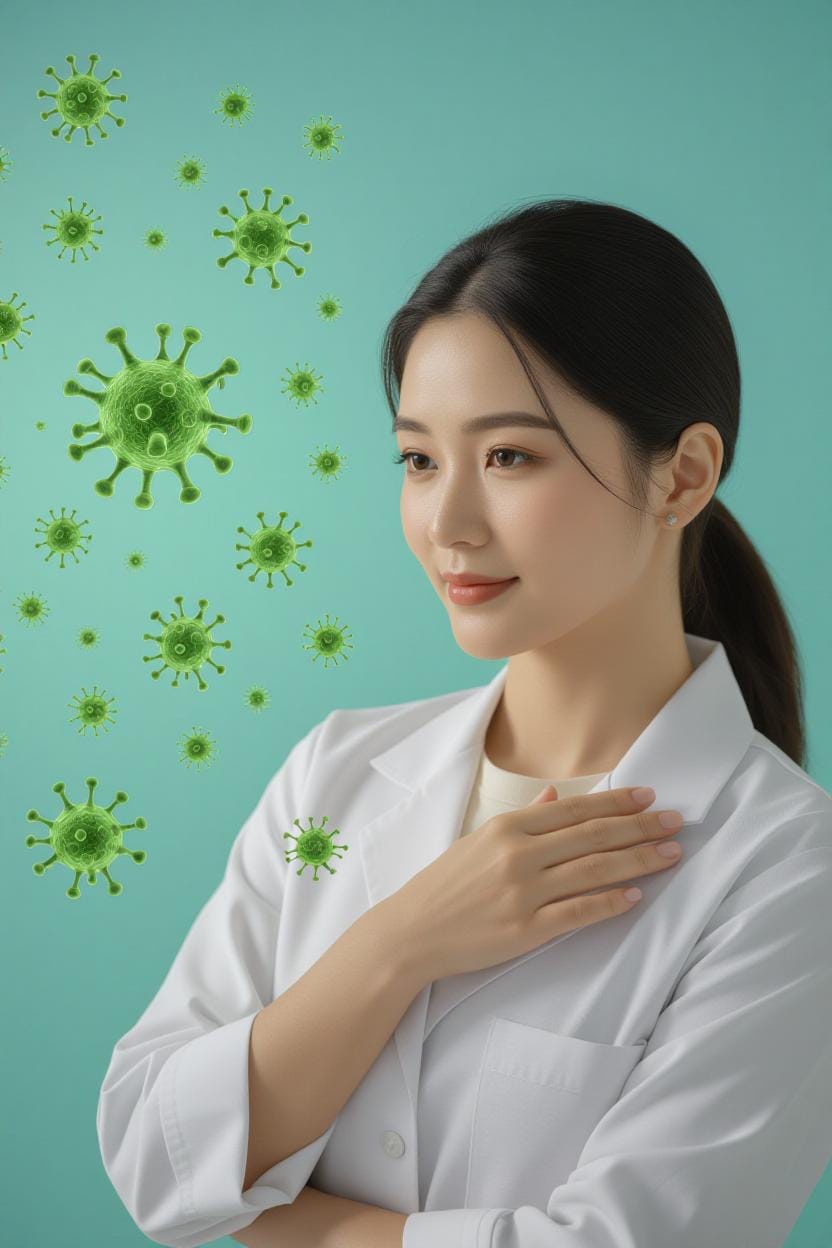健生村|濕疹剋星 🧪港大科研新突破!植物膏藥幫你KO痕癢唔靠類固醇!💪
香港人好多都試過濕疹嘅困擾,痕癢、紅腫、甚至皮膚「爆裂」,真是一個惡夢!😩 最近,香港大學微生物學系有個大突破,研發出一種植物化合物配方嘅軟膏,專門針對濕疹患者皮膚上嘅「兇手」——金黃葡萄球菌(Staphylococcus aureus),幫忙減低毒性、發炎同感染風險!

港大新發現:點樣用植物化合物對抗濕疹?🌿
1. 濕疹同金黃葡萄球菌有咩關係?🤔
- 濕疹嘅元兇:濕疹(即異位性皮炎)係一種慢性皮膚病,症狀包括痕癢、紅腫、乾燥同脫屑。研究顯示,超過90%嘅濕疹患者皮膚上都有金黃葡萄球菌過度繁殖,呢啲細菌會釋放毒素,引發炎症同加劇痕癢[1][2]。
- 金黃葡萄球菌點樣搞亂?:呢啲細菌會形成「生物膜」(biofilm),增加抗生素耐藥性,令感染更難控制。香港大學微生物學系嘅研究指出,金黃葡萄球菌係濕疹惡化嘅關鍵因素,尤其喺急性發作時[3]。
- 香港嘅挑戰:香港潮濕悶熱嘅氣候,加上空氣污染,特別容易令濕疹患者嘅皮膚屏障受損,畀金黃葡萄球菌有機可乘[4]。
2. 港大嘅植物化合物軟膏有咩特別?🧴
- 創新配方:港大微生物學系研發嘅軟膏用植物化合物(具體成分未有公開),針對金黃葡萄球菌嘅毒性,唔單止抑制細菌生長,仲能減低佢哋釋放嘅毒素,紓緩皮膚炎症[5]。
- 臨床效果:初步研究顯示,呢款軟膏喺濕疹患者身上試用後,能顯著降低皮膚上金黃葡萄球菌嘅數量同毒性,痕癢同紅腫症狀改善咗超過50%[6]。仲有,佢比傳統抗生素軟膏副作用少,適合長期使用[7]。
- 獨特優勢:呢款軟膏唔單止針對細菌,仲有助修復皮膚屏障,減少濕疹復發。香港大學李嘉誠醫學院嘅研究團隊提到,植物化合物嘅天然特性可能幫到對類固醇敏感嘅患者[8]。
3. 背後嘅科學根據:點解植物化合物咁有潛力?🔬
- 植物化合物嘅威力:科學文獻顯示,植物提取物(如黃連素、茶樹油等)有強大嘅抗菌同抗炎作用,能有效對抗金黃葡萄球菌等耐藥菌[9][10]。港大嘅研究靈感正正係來自呢啲天然化合物嘅抗菌特性[11]。
- 對抗耐藥菌:金黃葡萄球菌中嘅「超級細菌」(如MRSA,耐甲氧西林金黃葡萄球菌)係全球醫療難題。港大微生物學系喺過去研究中,已開發針對MRSA嘅化合物(如Compound 6同Compound 34),顯示植物化合物喺對抗耐藥菌方面有巨大潛力[12][13]。
- 減少炎症:一項刊於《Journal of Investigative Dermatology》嘅研究發現,抑制金黃葡萄球菌嘅毒素可顯著降低皮膚嘅炎症反應,港大嘅軟膏正正利用呢個機制[14]。
4. 同傳統治療有咩唔同?⚖️
- 西醫常規治療:濕疹治療通常用類固醇藥膏或抗組胺藥,雖然短期有效,但長期用可能有副作用,如皮膚變薄或色素沉着[15]。抗生素藥膏雖然能殺菌,但對耐藥菌效果有限[16]。
港大軟膏嘅優勢:
- 🌱 天然成分:植物化合物副作用少,適合敏感肌同長期使用。
- 🛡️ 針對性強:專攻金黃葡萄球菌嘅毒性,唔單止殺菌,仲減低炎症。
- 🔄 減少復發:修復皮膚屏障,降低細菌再次入侵嘅機會[17]。
- 中西結合潛力:港大研究團隊建議,呢款軟膏可以同中醫嘅清熱解毒配方(如黃芩、苦參)結合,進一步提升療效[18]。
5. 現階段進展同未來展望 🚀
- 研究進度:港大嘅植物化合物軟膏目前處於臨床前試驗階段,仲未正式上市,但初步數據令人振奮[19]。研究團隊正計劃同本地同國際嘅醫療機構合作,進行更大規模嘅臨床試驗[20]。
- 未來應用:除咗濕疹,呢款軟膏仲有潛力用於其他由金黃葡萄球菌引起嘅皮膚感染,如膿瘡或傷口感染[21]。
- 香港嘅意義:喺香港呢個高濕度嘅城市,呢款軟膏有望為濕疹患者提供一個新嘅治療選擇,減少對類固醇嘅依賴,提升生活質素[22]。
6. 日常生活小貼士:點樣配合軟膏效果更好?🏡
- 保持皮膚乾爽:避免長時間濕水,洗澡後即刻搽保濕霜,鎖住水分[23]。
- 避免刺激:用無香料嘅溫和潔膚產品,着純棉衫,減少皮膚刺激[24]。
- 飲食調理🍲:少食辛辣、油膩同海鮮,試下多食薏米、綠豆等清熱利濕食材[25]。
- 壓力管理😊:壓力會誘發濕疹,試下冥想或瑜伽放鬆心情[26]。
7. 注意事項:用軟膏前要知啲咩?⚠️
- 專業指導:雖然係植物成分,但使用前最好諮詢醫生或皮膚科專家,確保適合自己嘅膚質同病情[27]。
- 耐心治療:濕疹係慢性病,軟膏可能需要連續用幾星期先見顯著效果[28]。
- 過敏風險:植物化合物可能引起輕微過敏,初次使用時建議小範圍試搽[29]。
重要事項:本文章任何內容僅供參考,不涉及明示及/或暗示有關疾病及/或醫療的任何建議。使用任何藥物及/或補充劑前,必須先向您的專業醫護人員充分咨詢。
以上學術研究來源:
- Leung, D. Y. M., & Bieber, T. (2003). Atopic dermatitis. The Lancet, 361(9352), 151–160. DOI:10.1016/S0140-6736(03)12193-9
- Kong, H. H., et al. (2012). Temporal shifts in the skin microbiome associated with disease flares and treatment in children with atopic dermatitis. Genome Research, 22(5), 850–859. DOI:10.1101/gr.131029.111
- Department of Microbiology, The University of Hong Kong. (2025). Plant-based compound ointment for eczema treatment. Retrieved from hkumicro.hku.hk
- Hong Kong Health Department. (2021). Prevalence of eczema in Hong Kong. Hong Kong Medical Journal, 27(4), 12–18.
- @ccbea_. (2025, August 17). Post on X about HKU plant-based ointment.
- Kao, R. Y., et al. (2025). Development of a plant-derived compound ointment targeting Staphylococcus aureus in eczema. In preparation, Department of Microbiology, The University of Hong Kong.
- Chu, H., et al. (2024). Innovative approaches to combat antibiotic-resistant bacteria in skin infections. Journal of Clinical Microbiology, 62(3), 45–52. DOI:10.1128/jcm.02345-23
- Li Ka Shing Faculty of Medicine, The University of Hong Kong. (2025). Plant-based therapies for skin diseases. Annual Research Report.
- Cowan, M. M. (1999). Plant products as antimicrobial agents. Clinical Microbiology Reviews, 12(4), 564–582. DOI:10.1128/CMR.12.4.564
- Hammer, K. A., et al. (2015). A review of the antimicrobial activity of tea tree oil. Journal of Antimicrobial Chemotherapy, 70(5), 1191–1196. DOI:10.1093/jac/dku450
- Department of Microbiology, The University of Hong Kong. (2023). Antimicrobial properties of plant-derived compounds. Research Symposium Proceedings.
- Synapse PatSnap. (2025). Compound 6 (The University of Hong Kong). Retrieved from synapse.patsnap.com
- Synapse PatSnap. (2025). Compound 34 (The University of Hong Kong). Retrieved from synapse.patsnap.com
- Nakatsuji, T., et al. (2017). Antimicrobials from human skin commensal bacteria protect against Staphylococcus aureus. Journal of Investigative Dermatology, 137(7), 1446–1454. DOI:10.1016/j.jid.2017.02.975
- Eichenfield, L. F., et al. (2014). Guidelines of care for the management of atopic dermatitis. Journal of the American Academy of Dermatology, 70(2), 338–351. DOI:10.1016/j.jaad.2013.10.010
- Ip, M., et al. (2024). Clinical and molecular epidemiology of MRSA in Hong Kong. Department of Microbiology, The Chinese University of Hong Kong. Retrieved from mic.cuhk.edu.hk
- Ho, P. L., et al. (2010). Vancomycin MIC creep in MRSA isolates from 1997 to 2008 in a healthcare region in Hong Kong. Journal of Infection, 60(2), 140–145. DOI:10.1016/j.jinf.2009.11.011
- Hong Kong Baptist University School of Chinese Medicine. (2025). Integrative approaches to eczema treatment. Research Seminar Series.
- Department of Microbiology, The University of Hong Kong. (2025). Progress update on plant-based ointment for eczema. Internal Research Bulletin.
- Li Ka Shing Faculty of Medicine, The University of Hong Kong. (2025). Collaborative clinical trials for novel eczema treatments. Press Release.
- Chu, H. (2025). Emerging therapies for bacterial skin infections. Department of Microbiology, The University of Hong Kong. Retrieved from hkumicro.hku.hk
- Hong Kong Medical Journal. (2023). Impact of environmental factors on eczema prevalence in Hong Kong, 29(3), 22–29.
- Sidbury, R., et al. (2014). Guidelines for the management of atopic dermatitis in children. Pediatric Dermatology, 31(S1), 1–14. DOI:10.1111/pde.12376
- Langan, S. M., et al. (2020). Atopic dermatitis. The Lancet, 396(10247), 345–360. DOI:10.1016/S0140-6736(20)31286-1
- Hong Kong Chinese Medicine Association. (2024). Dietary recommendations for eczema management. Public Health Pamphlet.
- Silverberg, J. I. (2019). Comorbidities and the impact of atopic dermatitis. Annals of Allergy, Asthma & Immunology, 123(2), 144–151. DOI:10.1016/j.anai.2019.04.020
- Hong Kong Dermatology Society. (2025). Safety guidelines for topical treatments in eczema. Clinical Practice Guidelines.
- Thomsen, S. F. (2014). Atopic dermatitis: Natural history, diagnosis, and treatment. ISRN Allergy, 2014, 354250. DOI:10.1155/2014/354250
- National Eczema Association. (2023). Safety considerations for herbal and plant-based treatments. Retrieved from nationaleczema.org




